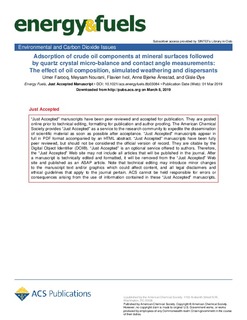| dc.contributor.author | Farooq, Umer | |
| dc.contributor.author | Nourani, Meysam | |
| dc.contributor.author | Ivol, Flavien | |
| dc.contributor.author | Årrestad, Anne Bjerke | |
| dc.contributor.author | Øye, Gisle | |
| dc.date.accessioned | 2019-04-03T11:11:02Z | |
| dc.date.available | 2019-04-03T11:11:02Z | |
| dc.date.created | 2019-03-12T14:57:10Z | |
| dc.date.issued | 2019 | |
| dc.identifier.issn | 0887-0624 | |
| dc.identifier.uri | http://hdl.handle.net/11250/2593141 | |
| dc.description.abstract | Improved knowledge of interactions between crude oil and solid surfaces is of great importance for understanding oil spill responses as well as oil spill behavior on land and in the near-shore environment. Here, the goal was to study how crude oils with various physicochemical properties interacted with model shoreline surfaces. In addition, the influence of simulated weathering and addition of dispersants was investigated for selected crude oils. A quartz crystal microbalance was used to follow the adsorption from 13 different crude oils on silica, aluminosilicate, and calcium carbonate surfaces, whereas the corresponding wettability alterations were followed by contact angle measurements. The polar crude oil components adsorbed in considerably higher amounts on the calcium carbonate surfaces than on the silica and aluminosilicate surfaces. The simulated weathering of oils resulted in increased adsorption onto both the silica and aluminosilicate surfaces, whereas it had a little effect on the calcium carbonate surface. The presence of dispersants generally reduced the amounts adsorbed on the surfaces. In the presence of seawater, the crude oil with a higher total acid number interacted strongest with the calcium carbonate surface. | nb_NO |
| dc.language.iso | eng | nb_NO |
| dc.publisher | American Chemical Society | nb_NO |
| dc.title | Adsorption of crude oil components at mineral surfaces followed by quartz crystal micro-balance and contact angle measurements: The effect of oil composition, simulated weathering and dispersants | nb_NO |
| dc.type | Journal article | nb_NO |
| dc.type | Peer reviewed | nb_NO |
| dc.description.version | acceptedVersion | nb_NO |
| dc.source.journal | Energy & Fuels | nb_NO |
| dc.identifier.doi | 10.1021/acs.energyfuels.8b03084 | |
| dc.identifier.cristin | 1684177 | |
| dc.description.localcode | © American Chemical Society 2019. This is the authors accepted and refereed manuscript to the article. Locked until 1 March 2020 due to copyright restrictions. | nb_NO |
| cristin.unitcode | 194,66,30,0 | |
| cristin.unitname | Institutt for kjemisk prosessteknologi | |
| cristin.ispublished | true | |
| cristin.fulltext | postprint | |
| cristin.qualitycode | 2 | |
